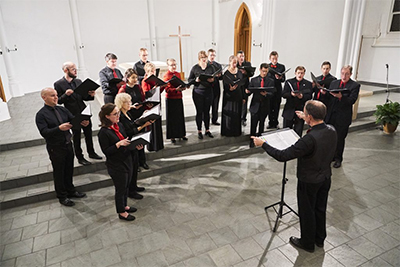by Daniel Hathaway

Although the program looked scholarly, presenting polyphonic music arranged according to the Sarum chants on which the motets were based, and might have appeared to be too much of a good thing, White constructed his playlist with a view toward variety of voicing. Full choir alternated with semi-choruses, and high voices with low — and he mixed earlier works by John Dunstable and Leonel Power among later and more complex pieces by William Byrd and Robert Parsons.
Subtle continental accents were provided by Peter Phillips and Richard Dering, who as Roman Catholics decamped to the Low Countries while Byrd remained in England after the Reformation, successfully continuing to be faithful to Rome while keeping his head on his shoulders.
Many of the 21 singers in this performance were carryovers from founder Ross W. Duffin’s ensemble, which established a fine reputation over its ten-year history. The group continues its tradition of fine, professional singing of the highest level. If White has changed anything in Quire’s sound, he’s moved it more in the direction of the intense style of tone cultivated by British cathedral choirs that makes it possible for them to fill cavernous spaces.
As a result, at certain moments, Quire’s treble voices can raise a Gothic vault by a couple of inches, and its basses can blaze through the rest of the ensemble. But the style is entirely appropriate to the music, and can create a riveting intensity.
The concert began with five men’s voices singing the Ave regina caelorum chant from the organ loft, answered by settings of that text by Dunstable and Power. Low voices followed with William Cornish’s Ave Maria, mater Dei, and three soloists stepped to the front for an alternatim performance of Dunstable’s Ave maris stella followed by Byrd’s setting.
The rest of the program followed suit, alternating chant with motets that included a setting of Regina caeli by Robert White, and Robert Parsons’ Ave Maria, which White told this publication in an interview “ends with one of the most beautiful ‘Amens’ ever written — including Franz Biebl’s.”
After Quire ended the concert with festive motets — Phillips’ Assumpta est Maria, and Byrd’s Beata es Virgo Maria — and received a warm, standing ovation, White announced an encore: the aforementioned Biebl setting of Ave Maria in a slightly truncated version. Following a program of sophisticated Renaissance polyphony, Biebl’s juicy ninth and seventh chords provided a toothsome dessert.
Published on ClevelandClassical.com May 14, 2019.
Click here for a printable copy of this article



